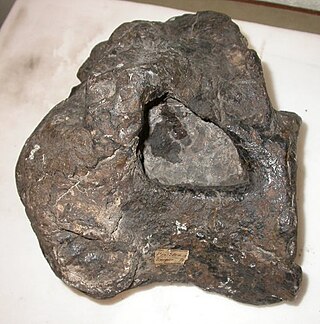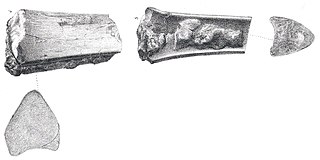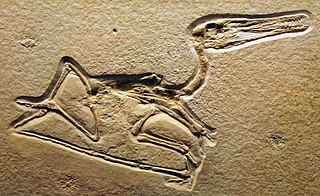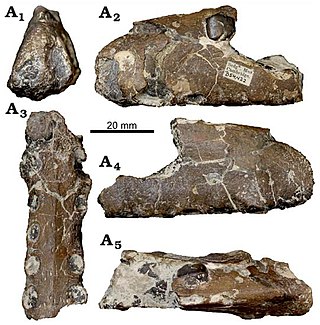Arthropods
Newly named insects
| Name | Novelty | Status | Authors | Age | Unit | Location | Notes | Images |
|---|---|---|---|---|---|---|---|---|
Sp. nov | jr synonym | Oustalet, 1870 | Oligocene | A bibionid, |  | |||
Sp nov | jr synonym | Oustalet, 1870 | Oligocene | A bibionid, |  | |||
| |||
|---|---|---|---|
| +... |
Paleontology or palaeontology is the study of prehistoric life forms on Earth through the examination of plant and animal fossils . [1] This includes the study of body fossils, tracks ( ichnites ), burrows , cast-off parts, fossilised feces ( coprolites ), palynomorphs and chemical residues . Because humans have encountered fossils for millennia, paleontology has a long history both before and after becoming formalized as a science . This article records significant discoveries and events related to paleontology that occurred or were published in the year 1870.
| Name | Novelty | Status | Authors | Age | Unit | Location | Notes | Images |
|---|---|---|---|---|---|---|---|---|
Sp. nov | jr synonym | Oustalet, 1870 | Oligocene | A bibionid, |  | |||
Sp nov | jr synonym | Oustalet, 1870 | Oligocene | A bibionid, |  | |||
| Name | Novelty | Status | Authors | Age | Unit | Location | Notes | Images | |
|---|---|---|---|---|---|---|---|---|---|
Gen et Sp nov | valid | A fish of possibly Percopsiformes affiliation. |  | ||||||
Sp nov | Jr synonym | A percopsid fish |  | ||||||
| Name | Novelty | Status | Authors | Age | Unit | Location | Notes | Images |
|---|---|---|---|---|---|---|---|---|
Gen et sp nov | valid | First identified as a possible basal sauropod. |  | |||||
| Name | Status | Authors | Location | Notes | |
|---|---|---|---|---|---|
Misidentification. | Misidentified bird. | ||||
| Name | Status | Authors | Location | Notes | Images | |
|---|---|---|---|---|---|---|
Possible subjective synonym of Allosaurus . | ||||||
| Earlier it was believed that the fossils were those of a pterosaur. But now it is known that they were the bones of a Sauropod. | ||||||
Valid | Bunzel | A dwarf ankylosaur. | ||||
| Name | Status | Authors | Location | Notes | |
|---|---|---|---|---|---|
Valid | Cope |
| |||
Valid | Cope | ||||
| Name | Status | Authors | Age | Location | Notes | Images |
|---|---|---|---|---|---|---|
Valid | Cope | 252 million years ago. | It was a protomammal that had fangs very similar to those of a walrus. |  | ||
Gigantosaurus is a dubious genus of Sauropod dinosaur from the Late Jurassic Kimmeridge Clay Formation of England. The type species, Gigantosaurus megalonyx, was named and described by Harry Govier Seeley in 1869.

Harry Govier Seeley was a British paleontologist.

Ornithocheirus is a pterosaur genus known from fragmentary fossil remains uncovered from sediments in the United Kingdom and possibly Morocco.

Ornithopsis is a genus of sauropod dinosaur, from the Early Cretaceous of England and possibly Germany. The type species, which is the only species seen as valid today, is O. hulkei, which is only known from fragmentary remains.

Tropeognathus is a genus of large pterosaurs from the late Early Cretaceous of South America. This genus is considered to be a member of the family Anhangueridae, however, several studies have also recovered it within another family called Ornithocheiridae. Both of these families are diverse groups of pterosaurs known for their keel-tipped snouts and large size. Tropeognathus is regarded as the largest pterosaur found in the Southern Hemisphere, only rivaled by the huge azhdarchids. The type and only species is Tropeognathus mesembrinus. Fossil remains of Tropeognathus have been recovered from the Romualdo Formation, which is a Lagerstätte located in the Santana Group of the Araripe Basin in northeastern Brazil.

Macrurosaurus is the name given to a genus of dinosaur from the Early Cretaceous. It was a titanosauriform which lived in what is now England. The type species, M. semnus, was named in 1876. A second species, M. platypus, may also exist.

Ornithostoma is a genus of pterodactyloid pterosaur that lived during the Early Cretaceous period of Europe, around 110 million years ago. Ornithostoma was once thought to have been a senior synonym of the pteranodontid Pteranodon due to its toothless anatomy and prior naming.

Cycnorhamphus is a genus of gallodactylid ctenochasmatoid pterosaur from the Late Jurassic period of France and Germany, about 152 million years ago. It is synonymous with the genus Gallodactylus.

Diopecephalus is a genus of pterodactyloid pterosaur from the Lower Tithonian of the Lithographic Limestone, Bavaria, Germany. The type and only species is D. kochi, although the name has been applied to Pterodactylus longicollum, with longicollum erroneously listed as the type species.

Lonchodectes was a genus of lonchodectid pterosaur from several formations dating to the Turonian of England, mostly in the area around Kent. The species belonging to it had been assigned to Ornithocheirus until David Unwin's work of the 1990s and 2000s. Several potential species are known; most are based on scrappy remains, and have gone through several other generic assignments. The genus is part of the complex taxonomy issues surrounding Early Cretaceous pterosaurs from Brazil and England, such as Amblydectes, Anhanguera, Coloborhynchus, and Ornithocheirus.
Paleontology or palaeontology is the study of prehistoric life forms on Earth through the examination of plant and animal fossils. This includes the study of body fossils, tracks (ichnites), burrows, cast-off parts, fossilised feces (coprolites), palynomorphs and chemical residues. Because humans have encountered fossils for millennia, paleontology has a long history both before and after becoming formalized as a science. This article records significant discoveries and events related to paleontology that occurred or were published in the year 1909.
Paleontology or palaeontology is the study of prehistoric life forms on Earth through the examination of plant and animal fossils. This includes the study of body fossils, tracks (ichnites), burrows, cast-off parts, fossilised feces (coprolites), palynomorphs and chemical residues. Because humans have encountered fossils for millennia, paleontology has a long history both before and after becoming formalized as a science. This article records significant discoveries and events related to paleontology that occurred or were published in the year 1869.

Colymbosaurus is a genus of cryptoclidid plesiosaur from the Late Jurassic (Callovian-Tithonian) of the UK and Svalbard, Norway. There are two currently recognized species, C. megadeirus and C. svalbardensis.

Ornithocheiridae is a group of pterosaurs within the suborder Pterodactyloidea. These pterosaurs were among the last to possess teeth. Members that belong to this group lived from the Early to Late Cretaceous periods, around 140 to 90 million years ago.

Pteranodontoidea is an extinct clade of ornithocheiroid pterosaurs from the Early to Late Cretaceous of Asia, Africa, Europe, North America and South America. It was named by Alexander Wilhelm Armin Kellner in 1996. In 2003, Kellner defined the clade as a node-based taxon consisting of the last common ancestor of Anhanguera, Pteranodon and all its descendants. The clade Ornithocheiroidea is sometimes considered to be the senior synonym of Pteranodontoidea, however it depends on its definition. Brian Andres in his analyses, converts Ornithocheiroidea using the definition of Kellner (2003) to avoid this synonymy.

Lonchodraco is a genus of lonchodraconid pterodactyloid pterosaur from the Late Cretaceous of southern England. The genus includes species that were previously assigned to other genera.

Camposipterus is a genus of pterodactyloid pterosaur from the Early Cretaceous of England. Fossil remains of Camposipterus dated back to the Early Cretaceous, about 112 million years ago.
Paleontology or palaeontology is the study of prehistoric life forms on Earth through the examination of plant and animal fossils. This includes the study of body fossils, tracks (ichnites), burrows, cast-off parts, fossilised feces (coprolites), palynomorphs and chemical residues. Because humans have encountered fossils for millennia, paleontology has a long history both before and after becoming formalized as a science. This article records significant discoveries and events related to paleontology that occurred or were published in the year 1849.

Ikrandraco is a genus of lonchodraconid pterodactyloid pterosaur known from the Lower Cretaceous Jiufotang Formation of northeastern China, and the Cambridge Greensand of England. It is notable for its unusual skull, which features a crest on the lower jaw.

Aerodraco is a genus of anhanguerid pterosaur from the Albian–Cenomanian-age Cambridge Greensand of England. It contains only one species, Aerodraco sedgwickii. It was originally assigned to the genus Pterodactylus.